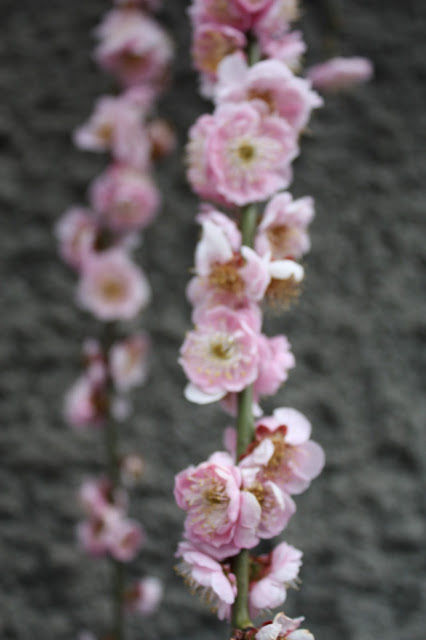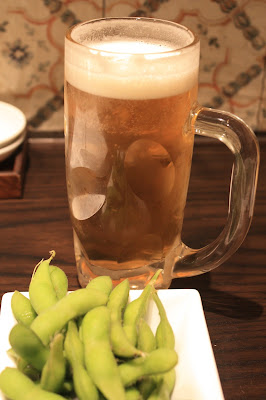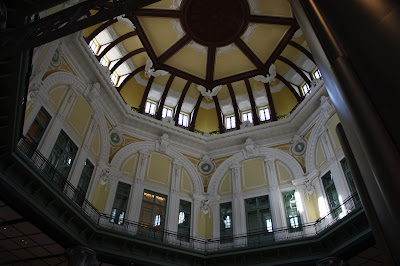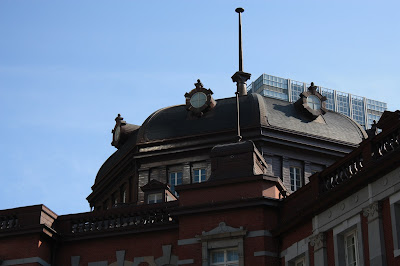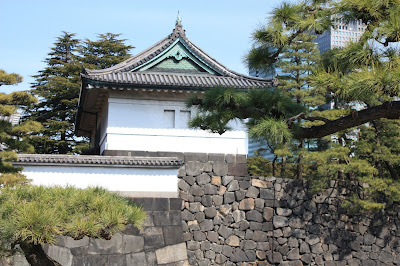On Saturday, I went to Nagoya for the day.
Nagoya has a subway and bus system. If you are going for a day, and plan to see several sites (or have business that takes to to several places), the day pass is a good choice. I used the Donichi Eco pass for the day. It bought it from a subway ticket vending machine and it cost 600 yen.
The bus from Nagoya Station to my first stop, the Tokugawa Art Museum, would have cost 450 yen one way, so you can see how this saves money. The weekday pass costs more, but both passes also cover the Nagoya's sight-seeing bus. It does not cover any JR trains, though.
If you're planning a trip to Nagoya in the near future, you may want to look at this site for more information: http://www.nagoya-info.jp/en/access/getting_around_nagoya/discount_tickets_passes/1-day_tickets_nagoya.html
I took the bus from Nagoya station, and saw this pretty garden on the way to the Tokugawa Art Museum.
Quiz: Are these cherry blossoms?
Answer: Nope. The petals are round a the end. Cherry blossom petals have splits at the end.
This, I believe, is a magnolia. I have lived where magnolias will happily grow, but don't remember it. I was pretty young then.
This is a statue of a tanuki, or a Japanese raccoon dog. Tanukis are real, actual animals. However, the tanuki plays a big role in Japanese folklore. The tanuki in folk stories can shapshift into humans, commit mischief and certain bits of anatomy are ridiculously large. This tanuki is modestly hiding those bits behind some foliage. If you wish to learn more, Wikipedia has a good-sized article on tanukis.
This is the gate to a house I saw. I just like the gate.
When I got to the park where the museum is, I ended up at a car park. I didn't see an obvious entry way, so I asked someone who had just pulled in. She kindly showed me the path in. I thought this was very cool.
This was a little low. The first part is the bottom of a hallway from one part of the museum to another. I like the idea of this gateway from the outside world into the park.
I imagine this is just a little cool and refreshing in the hot, humid summer months. If the plant that covers this was one that bloomed, that would be very cool.
On the other side, there are steps up to the normal street level again.
Here is the museum. Since it's a museum, I won't be able to take pictures on the inside. Sorry! I do recommend that you go, though. The museum houses many articles that were owned by members of the various branches of the Tokugawa family. Many of these branch families still exist.
Quick History Refresher: Tokugawa Ieyasu (family name is Tokugawa) established the Tokugawa shogunate which ruled Japan from the early 1600s to the mid 1800s. He was the basis for the titular character of the book "Shogun", in case you remember that.
Here is a path leading out of the park. There is also a garden that you can pay to see, but I think it will look it's best when spring has sprung and there's more foliage.

Here is the main gate to the park.
After leaving the park, I went to Ozone Station. No, that's not the ozone layer. Pronounce the fine "e" as somewhere in between a Canaadian "eh" and the Fonz's "ay".
It was noonish, so I went into a little restaurant outside the station and had this delicious mackeral lunch. In the back are: miso soup, a veggie salad, some pickles and tofu in broth. In front are rice and the roasted mackeral with grated radish. Yum! This trip has been nothing if not delicous!


Across the street from the temple is this building.

Here's a view of the shopping arcade. Many Japanese cities have these covered shopping areas. They are covered pedestrian streets, and I think they must be behind the idea of a shopping mall -- without the chain stores. Of course, there may be chain stores in a shopping street. I saw ABC Mart here -- it's a shoe store chain.
If my brother ever makes it over to Japan with me, I'll take him to this guitar store.

Not sure what they sell here. Maybe if your town is missing it's idiot, you can come here to get a new one.
Here's a shrine I saw in the middle of a commercial area.
One of the subway stations had some beautiful stained glass. I hope the people who race through here going to and from work get a chance to really look at it once in a while.
My next stop was the Sakae area. I was looking for either Tokyu Hands or Loft.
Here is Nagoya's TV to
Near the TV tower is subterranean shopping center. It connects to Oasis 21, which is a bus station, and shopping center.
It looks like this. I have pictures of it, which I can't find at the moment. This is from the Oasis 21's website. It looks like a spaceship!
The website is here, if you want more information: http://www.sakaepark.co.jp/en/
From below, it looks like this.
You can take steps or an elevator to the top. Here's the surprise -- there's water up here!
You can look down on unsuspecting people.

Or at other nearby areas.
I returned to Nagoya Station.

And had a nice dinner in the underground shopping area. Dinner was gyoza with edamame and a beer.
Outside, trees are lit up to look like cherry blossoms. Which are not yet blooming! I've been to Japan 6 times now and have yet to see sakura. Grr!

